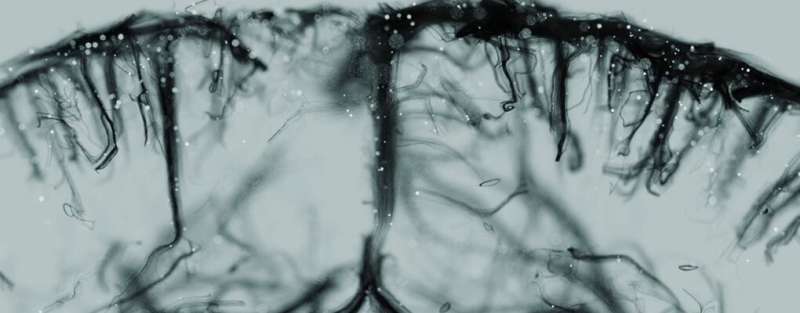Major advance in 3D ultrasound imaging to observe entire organs

Two successive studies by the Physics for Medicine Paris laboratory (ESPCI Paris-PSL, Inserm, CNRS) highlight advances in non-invasive 3D ultrasound imaging, making it possible to observe blood flow in real time in two whole organs, the heart and the brain. This work was published in JACC Cardiovascular Imaging and featured on the cover of eBioMedicine.
Organs are supplied by a complex network of blood vessels, which are essential for their proper functioning. Some imaging techniques give a global view of this vascular network, but for the first time, ultrafast 3D imaging allows us to observe blood flow from the large arteries to the smallest blood vessels of only a few micrometers in diameter.
For several years, the Physics for Medicine Paris laboratory has been a world leader in non-invasive, non-ionizing ultrasound imaging. The laboratory has made major advances in vascular imaging over the last 10 years, with the development of ultrasensitive Doppler imaging (uDoppler) and then ultrasound localization microscopy (ULM) in 2D. The technology is licensed to the company Iconeus (a start-up resulting from the laboratory's work) in the field of brain imaging, where it already has numerous applications in neuroscience research. Researchers at PhysMed have just reached a major milestone by deploying ULM in 3D. Thanks to the three-dimensional aspect, the researchers obtained super-resolved images of the rodent heart and brain, at the scale of the entire organ.
To achieve such a feat at such fine resolutions, the scientists inject microscopic gas bubbles, the position of which is monitored at high imaging rates. This makes it possible to obtain detailed information on blood flow and channel size, and thus to reconstruct the entire vascular activity of the organ. In addition to providing fundamental knowledge of organ function, this technique could also provide valuable information on various cardiovascular pathologies and even measure the effectiveness of different treatments.
A technological challenge
The team also had to overcome several technological challenges. For the heart, for example, it was necessary to find the ideal measurement window to be able to correct the movements linked to breathing and heartbeats on the image. For the brain, it may be necessary to implement post-processing algorithms to correct signal distortions induced by the skull. Moreover, the transition from 2D to 3D imaging implies a huge increase in the volume of data collected: for one minute of acquisition, the volume of data to be processed exceeds one terabyte of information.
Before considering a move into the human clinic, the scientists will further improve their technology by optimizing the sensors, electronics and data processing methods. But the team is confident that the scientific principle of 3D ultrasound microscopy and its technical feasibility have been demonstrated.
More information: Oscar Demeulenaere et al, Coronary Flow Assessment Using 3-Dimensional Ultrafast Ultrasound Localization Microscopy, JACC: Cardiovascular Imaging (2022). DOI: 10.1016/j.jcmg.2022.02.008
Oscar Demeulenaere et al, In vivo whole brain microvascular imaging in mice using transcranial 3D Ultrasound Localization Microscopy, eBioMedicine (2022). DOI: 10.1016/j.ebiom.2022.103995




















